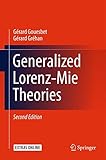Generalized Lorenz-Mie Theories [electronic resource] / by Gérard Gouesbet, Gérard Gréhan.
By: Gouesbet, Gérard [author.] .
.
Contributor(s): Gréhan, Gérard [author.] | SpringerLink (Online service)
| SpringerLink (Online service) .
.
Material type:  BookPublisher: Cham : Springer International Publishing : Imprint: Springer, 2017Edition: 2nd ed. 2017.Description: XXXVII, 331 p. 25 illus., 16 illus. in color. online resource.Content type: text Media type: computer Carrier type: online resourceISBN: 9783319468730.Subject(s): Fluid mechanics
BookPublisher: Cham : Springer International Publishing : Imprint: Springer, 2017Edition: 2nd ed. 2017.Description: XXXVII, 331 p. 25 illus., 16 illus. in color. online resource.Content type: text Media type: computer Carrier type: online resourceISBN: 9783319468730.Subject(s): Fluid mechanicsBackground in Maxwell’s Electromagnetism and Maxwell’s Equations -- Resolution of Special Maxwell‘s Equations -- Generalized Lorenz-Mie Theories in the Strict Sense, and other GLMTs -- Gaussian Beams, and Other Beams -- Finite Series -- Special Cases of Axisymmetric and Gaussian Beams -- The Localized Approximation and Localized Beam Models -- Applications, and Miscellaneous Issues -- Conclusion.
This book explores generalized Lorenz–Mie theories when the illuminating beam is an electromagnetic arbitrary shaped beam relying on the method of separation of variables. The new edition includes an additional chapter covering the latest advances in both research and applications, which are highly relevant for readers. Although it particularly focuses on the homogeneous sphere, the book also considers other regular particles. It discusses in detail the methods available for evaluating beam shape coefficients describing the illuminating beam. In addition it features applications used in many fields such as optical particle sizing and, more generally, optical particle characterization, morphology-dependent resonances and the mechanical effects of light for optical trapping, optical tweezers and optical stretchers. Furthermore, it provides various computer programs relevant to the content.


There are no comments for this item.